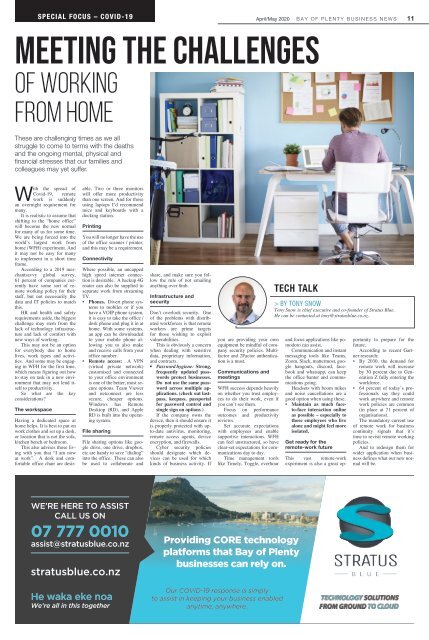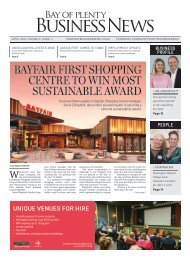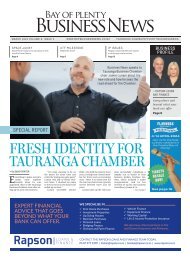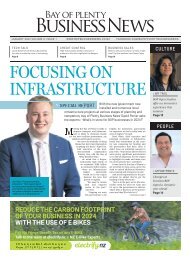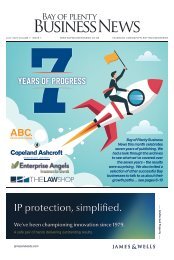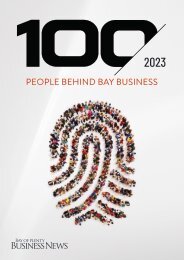April/May 2020 - BAY OF PLENTY BUSINESS NEWS
From mid-2016 Bay of Plenty businesses have a new voice, Bay of Plenty Business News. This new publication reflects the region’s growth and importance as part of the wider central North Island economy.
From mid-2016 Bay of Plenty businesses have a new voice, Bay of Plenty Business News. This new publication reflects the region’s growth and importance as part of the wider central North Island economy.
Create successful ePaper yourself
Turn your PDF publications into a flip-book with our unique Google optimized e-Paper software.
SPECIAL FOCUS – COVID-19<br />
<strong>April</strong>/<strong>May</strong> <strong>2020</strong> <strong>BAY</strong> <strong>OF</strong> <strong>PLENTY</strong> <strong>BUSINESS</strong> <strong>NEWS</strong> 11<br />
meeting the challenges<br />
of working<br />
from home<br />
These are challenging times as we all<br />
struggle to come to terms with the deaths<br />
and the ongoing mental, physical and<br />
financial stresses that our families and<br />
colleagues may yet suffer.<br />
With the spread of<br />
Covid-19, remote<br />
work is suddenly<br />
an overnight requirement for<br />
many.<br />
It is realistic to assume that<br />
shifting to the “home office”<br />
will become the new normal<br />
for many of us for some time.<br />
We are being forced into the<br />
world’s largest work from<br />
home (WFH) experiment. And<br />
it may not be easy for many<br />
to implement in a short time<br />
frame.<br />
According to a 2019 merchantsavvy<br />
global survey,<br />
61 percent of companies currently<br />
have some sort of remote<br />
working policy for their<br />
staff, but not necessarily the<br />
data and IT policies to match<br />
this.<br />
HR and health and safety<br />
requirements aside, the biggest<br />
challenge may stem from the<br />
lack of technology infrastructure<br />
and lack of comfort with<br />
new ways of working.<br />
This may not be an option<br />
for everybody due to home<br />
lives, work types and activities.<br />
And some may be engaging<br />
in WFH for the first time,<br />
which means figuring out how<br />
to stay on task in a new environment<br />
that may not lend itself<br />
to productivity.<br />
So what are the key<br />
considerations?<br />
The workspace<br />
Having a dedicated space at<br />
home helps. It is best to put on<br />
work clothes and set up a desk,<br />
or location that is not the sofa,<br />
kitchen bench or bedroom.<br />
This also advises those living<br />
with you that “I am now<br />
at work”. A desk and comfortable<br />
office chair are desirable.<br />
Two or three monitors<br />
will offer more productivity<br />
than one screen. And for those<br />
using laptops I’d recommend<br />
mice and keyboards with a<br />
docking station.<br />
Printing<br />
You will no longer have the use<br />
of the office scanner / printer,<br />
and this may be a requirement.<br />
Connectivity<br />
Where possible, an uncapped<br />
high speed internet connection<br />
is desirable. A backup 4G<br />
router can also be supplied to<br />
separate work from streaming<br />
TV.<br />
• Phones. Divert phone systems<br />
to mobiles or if you<br />
have a VOIP phone system,<br />
it is easy to take the office /<br />
desk phone and plug it in at<br />
home. With some systems,<br />
an app can be downloaded<br />
to your mobile phone allowing<br />
you to also make<br />
and receive calls from your<br />
office number.<br />
• Remote access: A VPN<br />
(virtual private network)<br />
customised and connected<br />
to your office environment<br />
is one of the better, most secure<br />
options. Team Viewer<br />
and netconnect are less<br />
secure, cheaper options.<br />
Windows has Remote<br />
Desktop (RD), and Apple<br />
RD is built into the operating<br />
system.<br />
File sharing<br />
File sharing options like google<br />
drive, one drive, dropbox,<br />
etc are handy to save “dialing”<br />
into the office. These can also<br />
be used to collaborate and<br />
share, and make sure you follow<br />
the rule of not emailing<br />
anything over 8mb.<br />
Infrastructure and<br />
security<br />
Don’t overlook security. One<br />
of the problems with distributed<br />
workforces is that remote<br />
workers are prime targets<br />
for those wishing to exploit<br />
vulnerabilities.<br />
This is obviously a concern<br />
when dealing with sensitive<br />
data, proprietary information,<br />
and contracts.<br />
• Password hygiene: Strong,<br />
frequently updated passwords<br />
protect businesses.<br />
Do not use the same password<br />
across multiple applications.<br />
(check out lastpass,<br />
keepass, passportal<br />
for password control and<br />
single sign on options )<br />
If the company owns the<br />
device, then it should ensure it<br />
is properly protected with upto-date<br />
antivirus, monitoring,<br />
remote access agents, device<br />
encryption, and firewalls.<br />
Cyber security policies<br />
should designate which devices<br />
can be used for which<br />
kinds of business activity. If<br />
you are providing your own<br />
equipment be mindful of company<br />
security policies. Multifactor<br />
and 2Factor authentication<br />
is a must.<br />
Communications and<br />
meetings<br />
WFH success depends heavily<br />
on whether you trust employees<br />
to do their work, even if<br />
you can’t see them.<br />
Focus on performance<br />
outcomes and productivity<br />
reviews.<br />
Set accurate expectations<br />
with employees and enable<br />
supportive interactions. WFH<br />
can feel unstructured, so have<br />
clear-set expectations for communications<br />
day to day.<br />
Time management tools<br />
like Timely, Toggle, everhour<br />
TECH TALK<br />
> BY TONY SNOW<br />
Tony Snow is chief executive and co-founder of Stratus Blue.<br />
He can be contacted at tony@stratusblue.co.nz.<br />
and focus applications like pomodoro<br />
can assist.<br />
Communication and instant<br />
messaging tools like Teams,<br />
Zoom, Slack, mattermost, google<br />
hangouts, discord, facebook<br />
and whatsapp, can keep<br />
the office banter and communications<br />
going.<br />
Headsets with boom mikes<br />
and noise cancellations are a<br />
good option when using these.<br />
• Maintain as much faceto-face<br />
interaction online<br />
as possible – especially to<br />
those employees who live<br />
alone and might feel more<br />
isolated.<br />
Get ready for the<br />
remote-work future<br />
This vast remote-work<br />
experiment is also a great opportunity<br />
to prepare for the<br />
future.<br />
According to recent Gartner<br />
research:<br />
• By 2030, the demand for<br />
remote work will increase<br />
by 30 percent due to Generation<br />
Z fully entering the<br />
workforce.<br />
• 64 percent of today’s professionals<br />
say they could<br />
work anywhere and remote<br />
work policies are common<br />
(in place at 71 percent of<br />
organisations).<br />
The mandatory current use<br />
of remote work for business<br />
continuity signals that it’s<br />
time to revisit remote working<br />
policies.<br />
And to redesign them for<br />
wider application when business<br />
defines what our new normal<br />
will be.<br />
WE’RE HERE TO ASSIST<br />
CALL US ON<br />
07 777 0010<br />
assist@stratusblue.co.nz<br />
stratusblue.co.nz<br />
He waka eke noa<br />
We’re all in this together<br />
Providing CORE technology<br />
platforms that Bay of Plenty<br />
businesses can rely on.<br />
Our COVID-19 response is simply<br />
to assist in keeping your business enabled<br />
anytime, anywhere.


